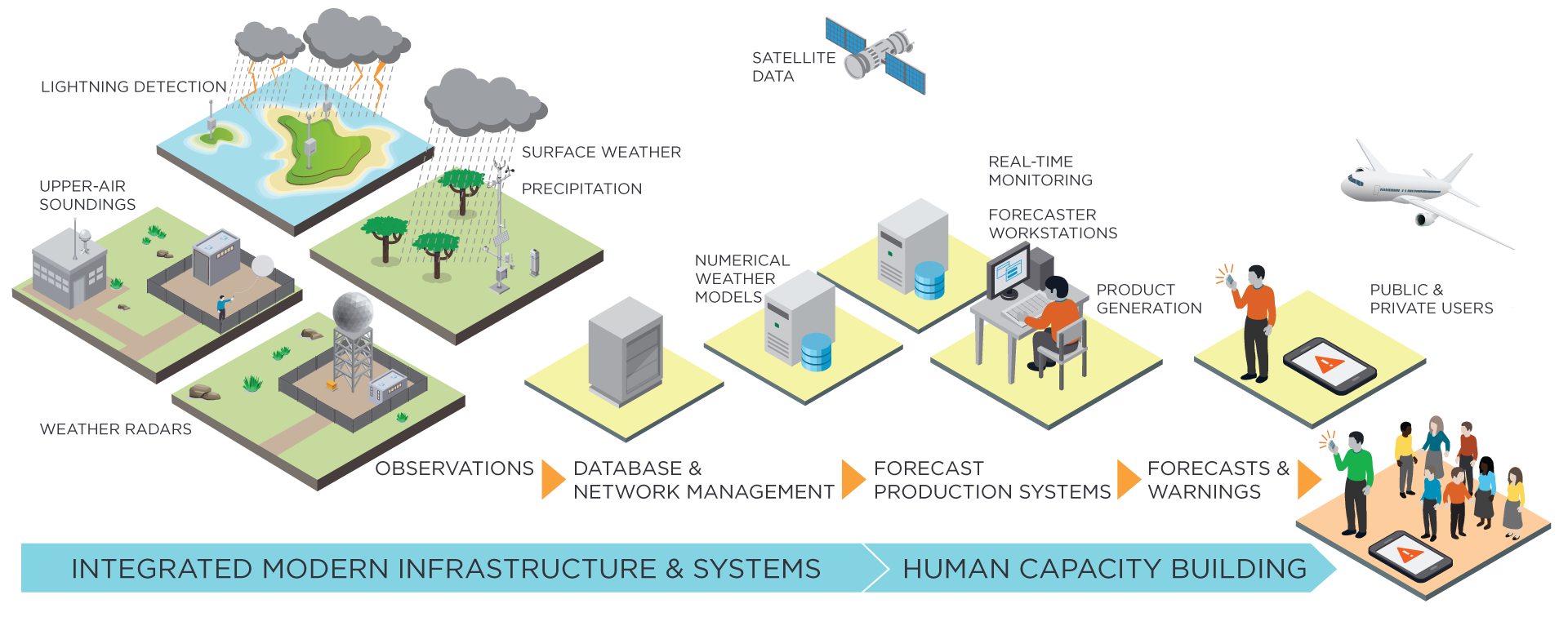Enabling early warnings
Tomorrow’s uncertainties are inevitable. Being caught unprepared is not.
We cannot control the weather, but we can reduce its impact on vulnerable communities. Despite our vastly improved abilities to observe, study, and forecast weather that impacts our livelihoods, available technology is still underused. Ignoring the many potential applications of weather monitoring continues to cost our society billions of dollars and thousands of human lives.
Meteorological infrastructure and capability development is the practice of improving national resiliency by putting technology to its appropriate uses. When enacted, the result is that governments, businesses, and citizens are to take concrete, coordinated actions that mitigate the effects of disasters ahead of time. They can successfully protect key resources and infrastructures, as well as enable quicker and more efficient recovery efforts.
Protect your country, protect your partners
It isn’t just individual countries that are affected by natural disasters. As we have seen with recent hurricane, tsunami, and earthquake events, impacts can spread from one country to the next as economies, trade, travel, and other factors are disrupted.
Therefore, any investment made in meteorological capacity will shield others around the globe from the secondary consequences of the next storm.
While many countries already access international warning systems and weather networks, one crucial value of improved meteorological capacity is that it provides local insights. More granular data, when disseminated correctly, enables targeted interventions and preparations that are impossible using other networks. An effective early warning system is based on accurate and dependable weather detection systems, that empower individuals and communities to respond promptly and appropriately to threats to reduce death, injury, and property damage.
Eyes on early warnings and early action in Africa
In an effort to maintain and deepen the active cooperation between public institutions and private organizations, Vaisala participated in the Ministerial Meeting on Integrated Early Warning and Early Action System Initiative. The meeting is held in Maputo, Mozambique on September 5-9, 2022, and the participants worked on a regional blueprint for implementing the call of United Nations Secretary-General Antonio Guterres that every person on earth should be protected by early warning systems in the next five years.
“Extreme weather and climate events such as severe floods, droughts, tropical cyclones and storms, heat waves and coastal flooding have eroded development gains and threaten the lives of hundreds of thousands. Early warnings are not a luxury, they are an essential tool in climate adaptation.” said WMO Secretary-General Prof. Petteri Taalas.
“One-third of the world’s people, mainly in the least developed countries and small island developing states, are still not covered by early warning systems. In Africa, 60% of people lack coverage. This is unacceptable. To help these countries meet Target G of the Sendai Framework, international support must be enhanced so that they can build and expand their early warning systems.” said Mami Mizutori, Special Representative of the Secretary-General for Disaster Risk Reduction and Head of the UN Office for Disaster Risk Reduction (UNDRR).
The recently published WMO State of the Climate in Africa 2021 report examines the impacts on lives and livelihoods in greater detail. It states, for example, that currently only 40 percent of the African population have access to early warning systems to protect them against extreme weather and climate change impacts. The report calls for strengthening of early warning systems, increase in transboundary cooperation, data exchange and knowledge sharing. It also discloses that currently, 28 African countries provide climate services from basic to essential level and only 9 provide those services at a full level; therefore there is an urgent need to improve climate services provision in Africa.
The need for one, integrated solution
Localized observation technology is only the first step, and any new infrastructure should be unified as a single solution - complete with centralized management, communications, and analytics functions. This ensures that the data from the observation network can be used. A patchwork of different vendors and solutions is likely to create complexity, redundant procurement, and cost inefficiency, as well as incompatibilities that can render even the best data unusable.
Integrated, holistic approach to enabling forecasts and early warnings.
Finnish expertise helps Ethiopia prepare for extreme weather phenomena
Vaisala will deliver a turnkey meteorological solution for the National Meteorology Agency (NMA) in Ethiopia together with the Finnish Meteorological Institute (FMI). The project will help Ethiopia to become more resilient to climate change and promote the nation’s sustainable development, and to build up capabilities that improve their capacity to predict and warn about extreme weather. Top-of-the-line environmental observations, forecasting, and early warning systems help safeguard both lives and property.
“Ethiopia faces hazardous weather events such as droughts, floods, hail and heavy precipitation. These events are expected to increase in both frequency and intensity, and to mitigate the impacts, we need action on many levels of society. The importance of reliable weather measurements and forecasts to protect lives and property is constantly growing. Adaptation to climate change is important for all African countries, which are particularly vulnerable to extreme weather phenomena,” said Jarkko Sairanen, Executive Vice President, Weather and Environment, Vaisala.
“When extreme weather strikes, reliable early warnings are crucial for people and organizations to be prepared. Thanks to our meteorological solution as well as the forecasting systems and training provided by the Finnish Meteorological Institute, NMA will be able to provide better weather services to Ethiopian people and thus mitigate the consequences of extreme weather events to local economies and livelihoods,” said Panu Partanen, Vice President, Weather and Environment, Vaisala.
“Through this unique Finnish public-private partnership, we are able to deliver a seamless integrated solution. Vaisala’s high-end observation system integrated with FMI’s state of the art forecast production system covers the whole value chain of the National Meteorology Agency. This will enable much needed weather-related services for different sectors of society,” said Harri Pietarila, Head of Expert Services of FMI.
Vaisala’s comprehensive Meteorological Infrastructure & Capability Development offering works to improve national resiliency through implementation of weather observation solutions.
From detection and analysis to forecasting and monitoring, the work of meteorologists is as complex as it is vital to local communities. Technology that aggregates and assimilates observational data of various types and formats in one place allows forecasters to make faster, better-informed decisions.


